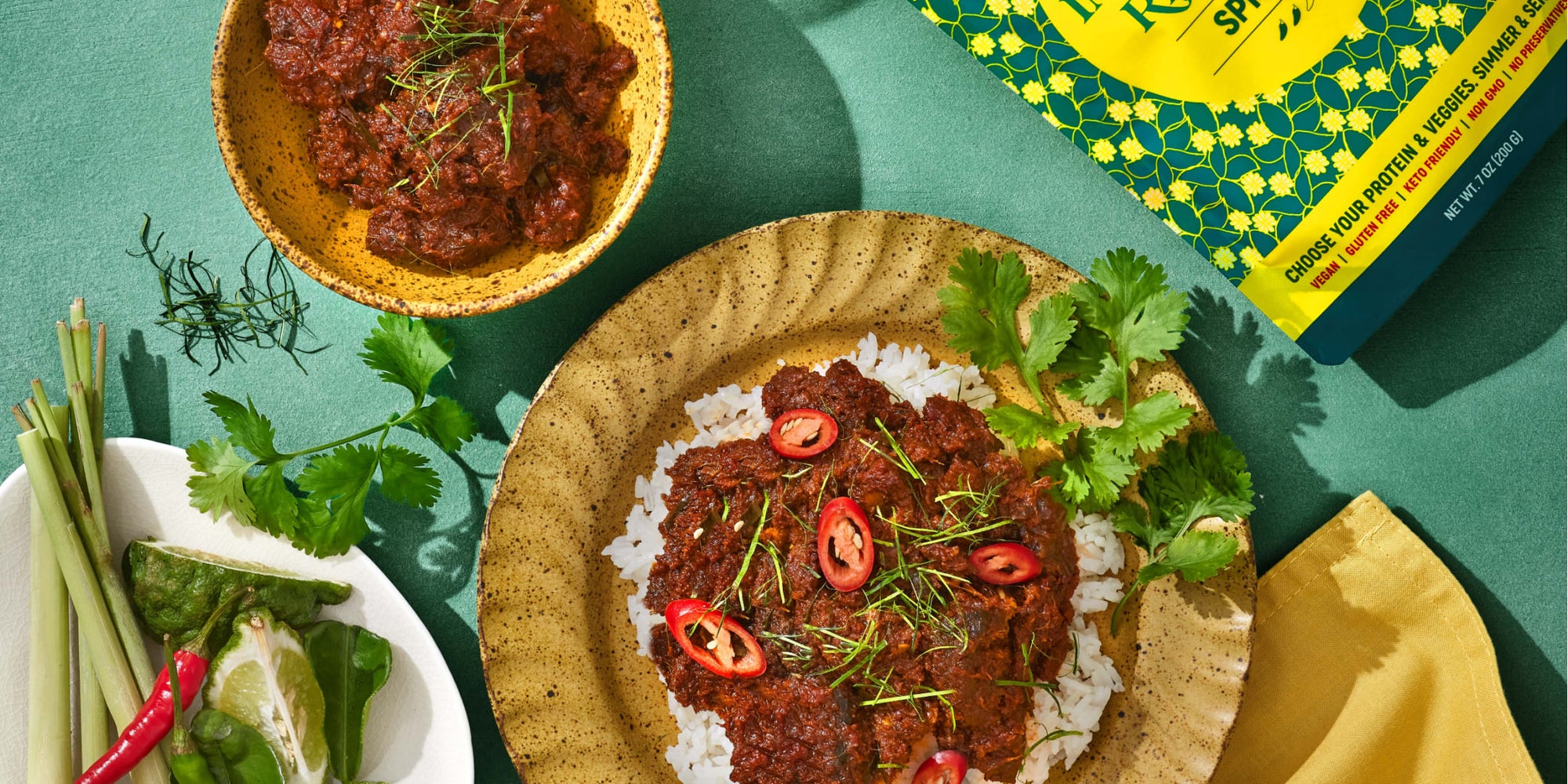Indonesian Rendang
Rendang is one of the keystone dishes representative of Southeast Asian cuisine. We’re not kidding — rendang was voted the world’s most delicious food in 2017 by CNN. At its core, a rendang is made of hunks of meat simmered for hours, sometimes days in a potent potpourri of spice and coconut milk, turning into a dark, caramelized, salaciously aromatic pot of spoon-tender meat stew. Think of it like a dry, intensely flavorful curry. Served at any lunch or dinner, a rendang is guaranteed to be the star of the meal, outshining all other dishes with its gloriously spice-rich flavor.
The dish originates from the Minangkabau region of Indonesia; but today rendang is popular throughout the Malay archipelago, including in Malaysia, Singapore, Brunei, and parts of Thailand. At any Indonesian restaurant around the world, you’ll likely find rendang as a star item on the menu. This speaks of rendang's universal culinary appeal: it’s hard to resist its intensely tender, moist and luxuriant texture and flavor. Plus, on top of the usual ingredients in Southeast Asian curries — lemongrass, cumin, coriander seeds, galangal, and chiles — rendang boasts a prominent cinnamon flavor, and the spices are cooked with the meat for much longer, resulting in a more intense, dryer curry.
Historically, this low-moisture, high fat-to-meat ratio of cooking rendang was done to preserve the meat. The coconut milk is cooked down for hours (or the whole day at a feast), reducing it into an intensely caramelized, molasses-like sauce that clings onto the hunks of meat — a jammy beef stroganoff, only with a lip-smacking Southeast Asian spice profile. Not only does this make rendang the choice dish for long travels in the hot, humid Southeast Asian climate, it inadvertently resulted in an exponentially more explosive dish. Just think about the labor of love that goes into making a rendang, along with the amount of time it takes, and the spice and flavor that goes in it. It’s as if five curries were concentrated into one singular dish.
Served on top of rice, or scooped up with a swab of roti or bread, or even just eaten on its own, there’s a guaranteed joy in chowing down a pot of rendang, the lava-like sauce dribbling down your chin, the fragrance of the coconut milk and herbs permeating your senses. To me, there’s little else that’s quite as glorious.
The biggest secret is to make enough rendang to keep in the fridge for 4-5 days. In fact, rendang is absolutely better the next day — like many classic stews in other cultures, the more rendang there is to keep, the deeper its flavor (and the happier your family) will become.
NOTES
- Protein: Beef is the most common protein for a rendang. We recommend using short rib or brisket, which will take at least 40 minutes of simmering. Lamb stew meat can also be used in place of beef. Alternatively, for shorter cook times, go with chicken or mushrooms—hardy ones like king oyster mushrooms and lion’s mane mushrooms hold up particularly well. Boneless chicken will take 20 minutes and mushrooms 10 minutes of simmering, respectively.
- Optional boost -- kerisik and turmeric leaves: There are two extra ingredients that add a classic boost to traditional rendangs — “kerisik” and sliced turmeric leaves. Kerisik are coconut shavings that are grated, toasted, then pounded into a buttery paste for a floral, molasses-like aroma. Turmeric leaves are sliced into thin ribbons or chiffonade, then folded into the rendang as it finishes cooking. The residual heat from the rendang itself will bring out the fragrance of the leaves, adding a fresh layer of aroma. While turmeric can be made from desiccated coconut, turmeric leaves may be hard to find. Nonetheless, these are completely optional ingredients; you will make kick-ass rendang with or without them.
- Simmering: If using beef, due to the long simmer and different cook times, be vigilant about checking for burning and feel free to add water or coconut milk to the pot if the sauce is looking dry.
- Sauce texture: Rendangs often have a texture akin to a split sauce, with little curds or clumps of chile and spice. This happens because the liquid in the coconut milk will evaporate as the rendang simmers, leaving behind the coconut fat and oil, as well as the coconut solids, which then caramelizes and gives rendang its signature sweet, smoky, spiced flavor. So if you see a slick layer or oil start to pool at parts of your rendang, know that this is completely normal. In fact, it’s a sure sign that shows you’re on the right path.
-
Instant Pot cooking: While rendangs are traditionally sautéed and slow-simmered in pot or wok over the stovetop, this can be done equally well in an Instant Pot too. In fact, pressure-cooking a rendang will result in a softer, more yielding meat texture in a shorter time, though the sauce will be very slightly less rich and thick due to the pressure cooking.

Indonesian Rendang
SERVESTIME
215—45 min, depending on protein
INGREDIENTS
- 1 Homiah Indonesian Rendang Kit
- 1 lb cubed beef short ribs, chicken, or mixed mushrooms
- 1/3 cup coconut milk
- Optional: 4 tbsp desiccated coconut
- Optional: 2-3 makrut lime leaves, or 1 turmeric leaf, thinly sliced
METHOD
- Pour the Homiah Indonesian Rendang Kit into a saucepan or dutch oven, and sauté for 3-5 minutes on medium-high heat until it starts to sizzle.
- Add in the protein, and sauté for a further 5 minutes.
- Pour the coconut milk into the pot, bring it to a boil, then turn the heat down to low and simmer for 45 mins or until tender for beef, 20 minutes for chicken or 10 minutes for mushroom.
- (Optional: Home-made kerisik) If you choose to make your own kerisik, toast the desiccated coconut in a pan set over medium-high heat for 5-10 minutes until golden brown, then pound or blend until it turns into a grainy paste. Add to the curry during early simmer stage.
- (Option: Reducing the sauce) If the Rendang looks too watery, remove the meat/ protein with a slotted spoon and set aside. Then turn on to high heat and reduce the sauce for 10 - 15 mins. Reincorporate the meat.
- The rendang is best served with rice or any grain of your choice. It keeps well for up to 3-5 days in an airtight container in the refrigerator.
For Instant Pot method, click here
VARIATIONS
Ingredient alternatives based on dietary preferences:
- Beef short ribs: Chicken, or mixed mushrooms (lion’s manes or king oysters are recommended). For chicken, lower the simmering time (in step 3) to 20 minutes, and for mushrooms, lower it to 10 minutes.
- Coconut milk: Substitute some or all with chicken or vegetable stock for a low calorie option.
SHOP INGREDIENTS





![[BUNDLE] Laksa - 3 Pack](http://www.homiah.com/cdn/shop/files/Hero-Final_8df79024-8bbc-4a19-97c7-e12604da1a3e_small.png?v=1709701179)
![[BUNDLE] Red Curry - 3 Pack](http://www.homiah.com/cdn/shop/files/Hero-Final_small.png?v=1711629863)
![[BUNDLE] Rendang - 3 Pack](http://www.homiah.com/cdn/shop/files/Hero-Final_0814fbff-a2f0-486d-ad4e-aae1a64cc2dd_small.png?v=1711630179)






![[BUNDLE] Laksa - 3 Pack](http://www.homiah.com/cdn/shop/files/Hero-Final_8df79024-8bbc-4a19-97c7-e12604da1a3e_small.png?v=1709701179)
![[BUNDLE] Red Curry - 3 Pack](http://www.homiah.com/cdn/shop/files/Hero-Final_small.png?v=1711629863)
![[BUNDLE] Rendang - 3 Pack](http://www.homiah.com/cdn/shop/files/Hero-Final_0814fbff-a2f0-486d-ad4e-aae1a64cc2dd_small.png?v=1711630179)

